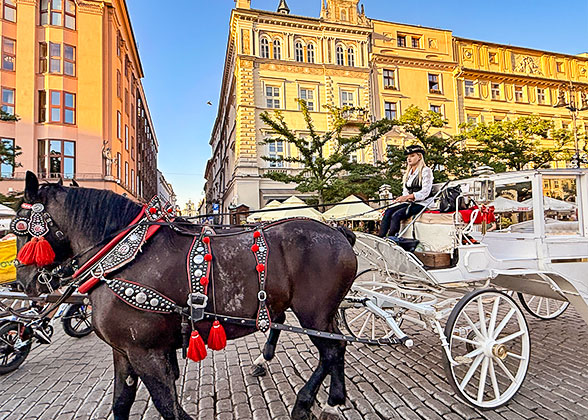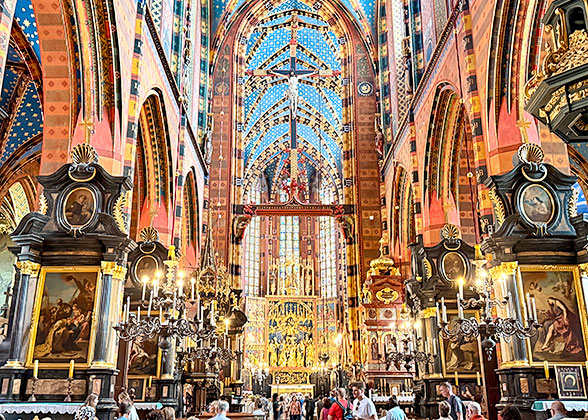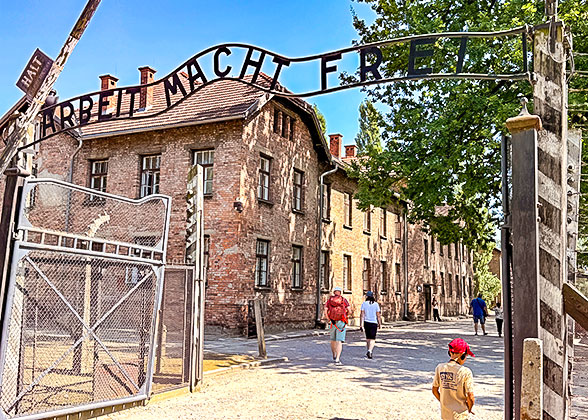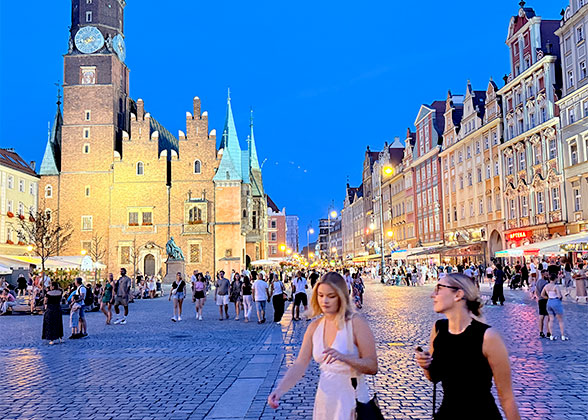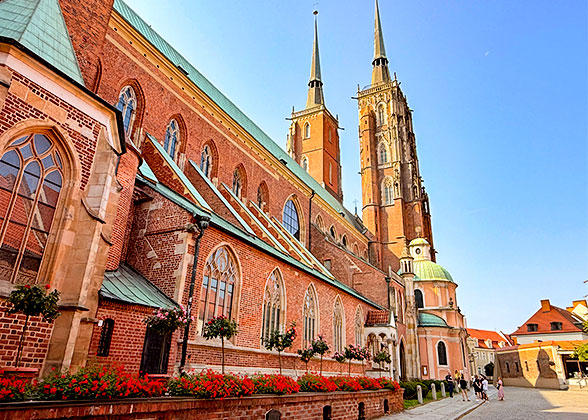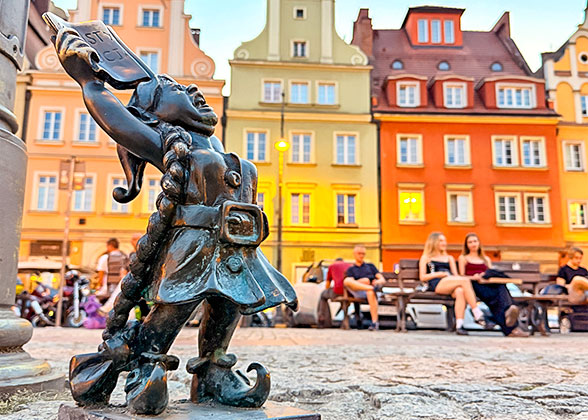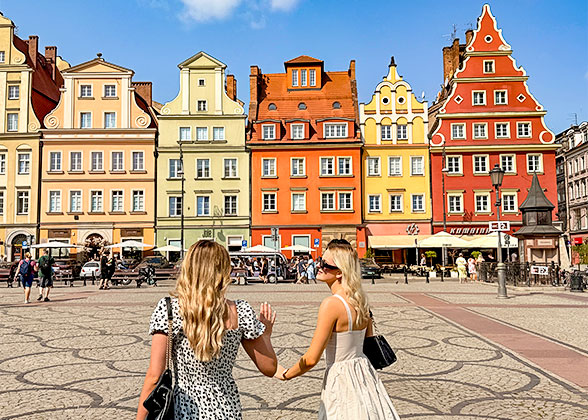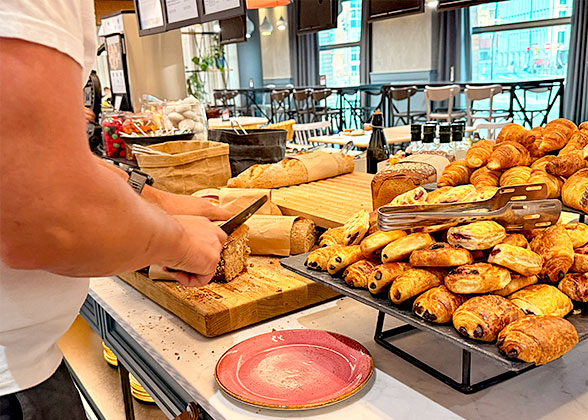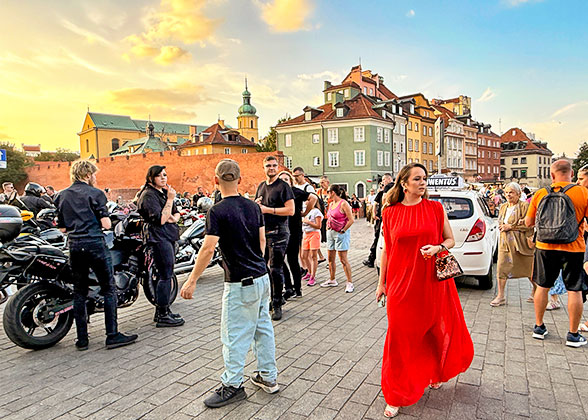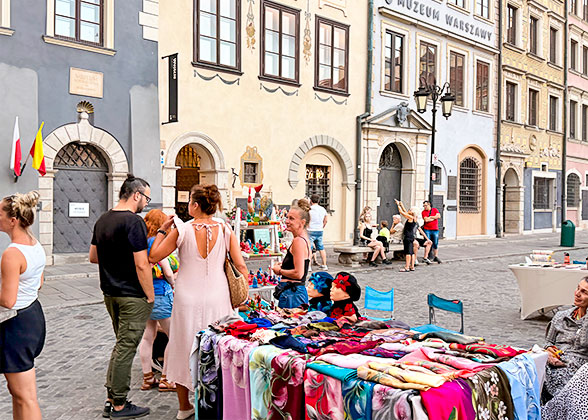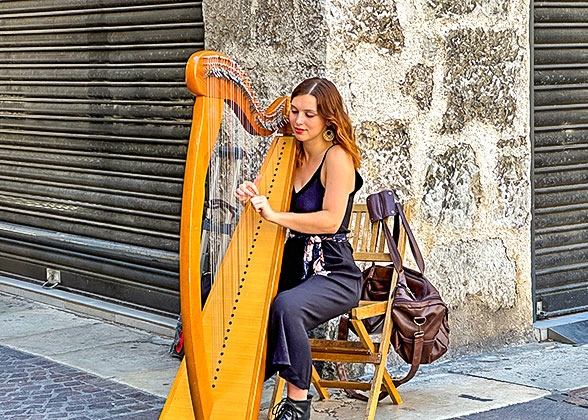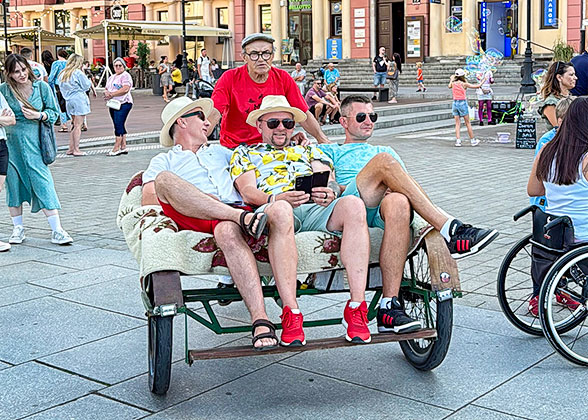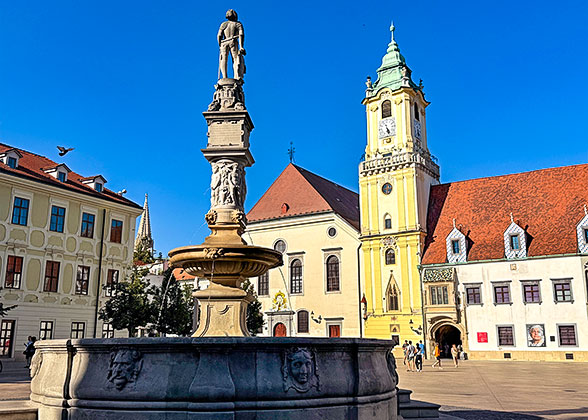Day 1: Arrival in Krakow, Airport Pick-up
Wawel Royal Castle in Krakow Thanks for choosing this Poland family trip and welcome to Krakow, the second largest city of Poland! Upon your arrival, our driver will wait for you at Krakow International Airport and transfer you to the hotel in Krakow old town in 30 minutes. After check-in, have a rest or walk around to get familiar with the city on your own. ► Tips on Buying a SIM Card There are four major network operators in Poland: Orange, T-Mobile, Plus and Play, each of which offers prepaid travel packages at reasonable prices. It’s easy to buy one at the airport, convenience stores and phone shops. SIM cards from Orange and T-Mobile are highly recommended. All packages of Orange include free social media apps. The most popular choices among tourists are: 30 GB data at 30 PLN (8 USD) and 45 GB data at 35 PLN (9.5 USD), which are both valid for 30 days. A SIM card from T-Mobile is 5 PLN (1.4 USD) with 1 GB of data, and you can add a package with 25 GB of data for 25 PLN (6.8 USD). ► Best Time to Visit Poland’s climate is relatively mild, with warm summer and cold winter. Generally, the best time to visit is from May to September. During this time the average temperature is about 20℃ (68℉), and there are lively festivals like Krakow Jewish Culture Festival and Warsaw Summer Jazz Days. If you want to avoid the crowds, late spring (May to June) and early autumn (September to October) are good choices. Accommodation: Hotel Mercure Krakow Stare Miasto (4 stars) or similar
|
Day 2: Krakow: Visit Wieliczka Salt Mine, Main Market Square & Wawel Hill
This morning, your private guide will pick you up from your hotel lobby and accompany you to visit Wieliczka Salt Mine, a UNESCO World Heritage site located 10 kilometers (6.2 miles) southeast of Krakow. It is one of the largest and the most remarkable salt mines in the world. The massive subterranean maze has a stunning size of 287 kilometers long (178 mi.) and a total of 9 levels. There are displays of the centuries-old machinery and transportation, ingenious systems for mining operations, as well as chapels and salt lakes. St Kinga’s Chapel is the most marvelous part of the mine. It is 12 meters high (40 ft.), 18 meters wide (60 ft.) and 54 meters long (177 ft.), intricately decorated with reliefs, statues, and a large chandelier. You could see a bas relief depicting The Last Supper and delicate religious sculptures. Everything that is sparking like crystal, from the altarpieces to the floor tiles, is entirely made of salt blocks. Remember to wear sturdy shoes since there are a lot of stairs. In the afternoon, we’ll drive back to downtown Krakow. Let’s explore the Main Market Square, one of the largest existing medieval squares in Europe whose origin could date back to 1257 AD. Colorfully-painted townhouses surround the square, within which stands the Monument to Adam Mickiewicz (1798-1855 AD) who is a great romantic poet of Poland. Marvel at the imposing twin spires of St Mary’s Basilica and the medieval Gothic Town Hall Tower. The Cloth Hall, nestled in the heart of the square, is attractive with its graceful Renaissance arcade and beige facade. Used to be a bustling silk and spice trading center in the 15th century, it is now packed with stands selling handicrafts, amber, and souvenirs. Then, let’s go to Wawel Hill. Located at the southernmost part of the old town area, it overlooks Vistula River, the mother river of Poland. On this 230-meter-high (754 ft.) hill are the most conspicuous landmarks of Krakow - Wawel Royal Castle and Wawel Cathedral. 1,000 years ago, after the coronation of the first King of Poland, Krakow became the capital city and political center. As the place for royal weddings and funerals for hundreds of years, Wawel Hill has an irreplaceable role in Polish history. See the Royal Tombs in Wawel Cathedral, and appreciate the collection of paintings from Italy, Netherlands, and France, as well as precious porcelain ware and silverware inside the castle. After the visit, the guide will escort you back to the hotel. Meals: Breakfast Accommodation: Hotel Mercure Krakow Stare Miasto (4 stars) or similar
|
Day 3: Transfer to Zakopane: Explore Krupowki Street & Take a Funicular up Gubalowka Hill
Today, your guide and driver will pick you up at the hotel and then we’ll leave for Zakopane, the southernmost city in Poland located at the foot of Tatra Mountains. Known as the “Winter Capital of Poland”, it is famous for its highlanders’ culture and winter sports. After arrival, enjoy some free time on Krupowki Street, the liveliest street in Zakopane, to embrace the local culture and discover the unique leather and wooden handicrafts. If interested, you may try some local specialties like the smoked sheep’s cheese called Oscypek at your own expense. Then, your guide will accompany you to take Poland’s first funicular to the top of Gubalowka Hill at an elevation of 1,126 meters (3,694 ft.). With its extraordinary natural scenery, the hill is a perfect destination for hiking and skiing. Look out over the rolling hills of Tatra Mountains which stretch across Poland and Slovakia for over 60 kilometers (37 mi.). Take a light walk on the hilltop, and take in the refreshing air and the beauty of nature. After that, the guide will escort you to the hotel in Zakopane.
► Tips: The temperature on the highland is unpredictable, so please remember to wear layers of clothes and be careful not to catch cold. It’s better to wear waterproof shoes because it might rain at any time on the mountain.
Meals: Breakfast
Accommodation: Bachleda Hotel Kasprowy, Zakopane (4 stars) or similar
|
Day 4: Zakopane - Auschwitz Concentration Camp - Wroclaw
This morning, the guide will pick you up and accompany you on a visit to Auschwitz Concentration Camp. Poland is one of the countries with the most fatalities in World War II (1939-1945 AD), and a large part of the casualties are Jews. According to statistics, 5.7 million of the 7.3 million Jews in Europe were victims of the Holocaust during the German-occupied period. Among them, approximately 2.83 million Jews were killed in concentration camps in Poland. The Nazis established three major concentration camps in Auschwitz, of which Auschwitz I was founded in 1940 AD for political prisoners, and Auschwitz II-Birkenau is the largest one with the largest number of deaths in Auschwitz. About one million Jews were brutally killed here. Walking through the gate of the camp, you could witness the remaining railway tracks, iron fences, barracks, gas chambers, and crematorium ovens. Historical records and photographs of the victims will uncover this heart-wrenching history and the cruel crimes of Nazi regime. ► Tip: Considering the seriousness of this place, please dress properly and lower your voice while visiting to show respect for the victims. After the visit, we’ll drive 2.5 hours to Wroclaw. Upon arrival, the guide will accompany you to check in at the hotel. Meals: Breakfast Accommodation: Hotel Mercure Wroclaw Centrum (4 stars) or similar
|
Day 5: Wroclaw Walking Tour with Cathedral Island, Market Square & University of Wroclaw
After breakfast at the hotel, the guide will meet you and start today’s walking tour of Wroclaw. With the Oder River meandering through the city, there are 12 islands and over 100 bridges connecting them in Wroclaw, giving it the nickname “Venice of Poland”. Cathedral Island (Ostrow Tumski) is the historic and religious center of the city, which witnesses the rise of Wroclaw, how it became a German city and how it was returned to Poland. Let’s go across Tumski Bridge, also known as “Lovers’ Bridge”, where numerous padlocks are attached by lovers. Then, you could soon realize that this small island, just as its name suggests, is sacred and serene with religious buildings everywhere. The 98-meter-tall (321 ft.) twin towers of Archcathedral of St. John the Baptist dominate the skyline with their Gothic spires. Afterward, go to the old town of Wroclaw and stroll around the Market Square, which is one of the largest squares in Europe. Its layout remains the same as the town planning of 1241 AD, though the majority of the buildings were restored after World War II. Here, get immersed in the timeless beauty of Baroque-style townhouses painted in various colors. The magnificent Old Town Hall is a masterpiece of Gothic architecture, with intricate carvings and an astronomical clock adorned its facade. Behind it, you could see a seated statue of the illustrious Polish writer Alexander Fredro (1793-1876 AD). Last, let’s visit the University of Wroclaw, which was formerly University of Breslau established in 1702 AD. It is one of Poland’s most prestigious universities, proud of being the alma mater of 10 Nobel Prize winners, including Erwin Schrodinger (1887-1961 AD) - the founder of quantum mechanics, and Theodor Mommsen (1817-1903 AD) - a historian and writer famous for his “History of Rome”. Aula Leopoldina Hall of the main building, elaborately decorated with spectacular statues and dazzling frescoes, showcases a marvel of Baroque from the 18th century. While admiring the beautiful campus buildings, you’ll learn about the role of the University of Wroclaw in the political and scientific development of Europe over the past few centuries. Thereafter, the guide will escort you back to your hotel. ★ A Fun Fact: There Are over 600 Dwarf Statues Hidden in Wroclaw!Chopper dwarf, musician dwarf, pizza delivery dwarf… Yes, you could surprisingly spot a tiny dwarf statue in almost every corner of Wroclaw! They are hanging on the street lamps, hiding under the sign of a building, or standing before a restaurant, each of which is only about 20 to 30 centimeters (8-12 in.) tall. The rise of the dwarfs was a humorous and satirical way to express the citizens’ dissent over the regime in the 1980s, and now they have become a cultural symbol of Wroclaw. Why not make hunting for dwarfs a fun side quest of your Wroclaw tour? Meals: Breakfast Accommodation: Hotel Mercure Wroclaw Centrum (4 stars) or similar
|
Day 6: Wroclaw - Poznan City Exploration - Torun
Town Square of Wroclaw This morning, the guide will pick you up at your hotel and then we’ll set out for Poznan by 2 hours’ private car transfer. The history of Poznan can be traced back at least to 970 AD. As the oldest capital of Poland, it houses the country’s first cathedral - Archcathedral Basilica of St. Peter and St. Paul, which is the final resting place of the first Polish King. Set your foot on the cobblestone streets, and delve into the artistic legacy of the thousand-year-old town. Four 18th-century Rococo fountains decorate the corners of the town square. The 61-meter-tall (200 ft.) Town Hall Tower is rather eye-catching with its gorgeous Renaissance loggia which is particularly mesmerizing with the changing sunlight and shadows. At 12:00 noon every day, two mechanical goats come from the tower’s clock to tell the time by butting each other with their horns, which has become a must-see in Poznan. In the afternoon, we’ll proceed to Torun in 2 hours. Your guide will accompany you to check in at the hotel. ► Recommended Evening Activities in Torun (at your own expense) If you want to explore the surroundings by yourself after arriving in Torun, you could walk south from your hotel to the bank of Vistula River and take a leisurely stroll along the promenade to enjoy the scenery. Or, it’s more recommended to cross the bridge to the other side of the river, where you could get a better view of the city’s skyline from the observation platform. Especially when Torun is lighted up at sunset, the scene could be breathtaking. In addition, you can go to Cosmopolis Fountain, a memorial to Copernicus, which is 500 meters away from your hotel. The free light and sound fountain show is worth watching. Note that the fountain show time varies in different seasons, so please confirm with your guide if you want to have a look. Meals: Breakfast Accommodation: Copernicus Torun Hotel (4 stars) or similar
|
Day 7: Medieval Town of Torun: House of Nicolaus Copernicus & St. Johns’ Cathedral; Transfer to Gdansk
Today, the guide will meet you at the hotel and accompany you to take a walking tour to the old town area of Torun, admiring the Gothic architecture and delving into the precious legacy left by the famous astronomer Nicolaus Copernicus (1473-1543 AD). Located in the west of Poland, Torun is a cultural city built by the Teutonic Order in 1232 AD. During World War II, although major cities in Poland were severely damaged, Torun was fortunately intact. With its original houses and streets, the Medieval Town of Torun is inscribed on the UNESCO World Heritage List. Let’s visit the Artus Court, rebuilt in the late 19th century, which features a three-story exterior made of red bricks and sandstone. It now functions as the Cultural Center of Torun and regularly hosts cultural events such as concerts and exhibitions. Next, explore the Church of the Holy Spirit, first built as a Lutheran church, in which the 18th-century wooden main altar is a masterpiece of Rococo art.
We’ll also see the Nicolaus Copernicus Monument erected in 1853 AD and House of Nicolaus Copernicus in the old town to gain a deeper understanding of the astronomer’s life and achievement. Copernicus was born in Torun in 1473 AD. Under the influence of Renaissance, he gradually grew into a young man who loved learning and thinking. Later, he put forward his most groundbreaking “Heliocentric Theory”, which marked a revolutionary change in the astronomical concept in Europe. Next, follow your guide to explore one of the landmarks of Torun - St. Johns’ Cathedral, or officially the Cathedral Basilica of St. John the Baptist and St. John the Evangelist, which was constructed in 1233 AD. It has a diverse collection of Renaissance and Baroque carvings and paintings, as well as items related to Copernicus such as his baptismal font, a tomb monument from 1580 AD, and a bust from 1766 AD. Then, we’ll head to Mostowa Gate, also called Bridge Gate, to see part of the ancient fortification of Torun. Built in 1432 AD by the Vistula River, it is the youngest of all 14 medieval gates of Torun, guarding the entrance of the city. Finally, we’ll drive 2 hours to Gdansk and the guide will help you check in at the hotel.
Meals: Breakfast
Accommodation: Qubus Hotel Gdansk (4 stars) or similar
|
Day 8: Gdansk: Visit St. Mary’s Church, Amber Museum & Museum of the Second World War
This morning, the guide will wait for you at the hotel and accompany you to visit Gdansk Old Town. Gdansk, the most important port city and the largest city in north Poland, was once the land where the Germans and the Slavs fought over. Along the Long Street (Dluga Street), we’ll see the elegant Neptune’s Fountain. Completed in 1633 AD, it features a bronze statue of the god of the sea in Roman mythology, indicating the inseparable relation between Gdansk and the Baltic Sea. Neptune, with a trident in his hand, is surrounded by sea nymphs and sea animals that showcase the beauty of Rococo art. Behind the fountain stands the iconic Artus Court. Around the 18th century, it was a meeting place of the merchants for business. The grandiose white facade is adorned with gold foil and sculptures, and the interior is a feast for art lovers with fine tapestries, paintings, wooden decorations, and ship models. See the striking 12-meter-tall (40 ft.) tiled stove, which is the world’s largest tiled stoves from the Renaissance. Further down the street, we’ll come to the majestic St. Mary’s Church. As the largest Gothic brick church in the world, it can accommodate at least 20,000 people. The highlights of the church are the impressive astronomical clock from 1464 AD, and the 82-meter-high (270 ft.) tower, the highest building in Gdansk, from which you could get a panoramic view of the city. In the afternoon, let’s visit the Amber Museum. Amber, also known as the “Baltic Gold”, is a natural gift from the Baltic Sea. Numerous pieces of amber have been washed onto the beaches of Gdansk over the past 6,000 years, making Gdansk “the Amber Capital of the World”. The Amber Museum, hidden in a historic building, abounds with a vast collection of natural amber specimens and crafts, including an invaluable 40-million-year-old “sunken lizard”, the only lizard amber ever found in Poland, and a Baroque-style amber cabinet dating back to 1724 AD. We’ll also visit the Museum of the Second World War, which is located adjacent to Westerplatte Peninsula, where the German battleship opened fire on Poland on September 1, 1939 AD and World War II began. The museum houses nearly 3,000 exhibits, including personal items such as letters and photographs donated by individuals. The exhibition uncovers the experiences of ordinary people during World War II through 3 major sections: The Road to War, The Horrors of War, and The War’s Long Shadow, bringing the tragic memories to life. Later, embark on a Motlawa River cruise to admire the historic architecture of the old town from the tranquil water, and soak up the ambience of Gdansk and the vast Baltic Sea. After that, the guide will escort you back to your hotel. ► Dinner Recommendation (at your own expense): The restaurant Pierogarnia Stary Mlyn Chmielna, a 5-minute walk from your hotel, is recommended if you want to savor some Polish food. Try some boiled, fried or baked Polish dumplings, or the Pierogi. The restaurant serves Pierogi with a variety of stuffing such as potatoes and mushrooms, and broth and chicken. The average cost per person is about 75 PLN (20 USD). Meals: Breakfast Accommodation: Qubus Hotel Gdansk (4 stars) or similar
|
Day 9: Tri-City Tour of Gdansk, Gdynia & Sopot
Tri-city is a metropolitan area composed of three adjacent Baltic coastal cities: Gdansk, Gdynia and Sopot. Today, the guide will escort your to further delve into Gdansk, and explore Gdynia, which has a rich maritime history, and the vibrant resort of Sopot. First, let’s go to Gdansk Shipyard, a spot famous for its political significance. Against the backdrop of economic crises and workers’ pay cuts, Lech Walesa organized Solidarity at the Shipyard in August 1980, and led nationwide movements against the Polish communist government. Witness the Monument to the Fallen Shipyard Workers of 1970 erected during the protests, and learn about how the movements influenced the communist dictatorships of Poland and Eastern Europe. Next, we’ll visit Gdynia to admire modern warship, and then enjoy the seaside scenery in Sopot. Walk along the wooden pier built in the 19th century that stretched 511.5 meters (1,678 ft.) into the sea and is the longest wooden pier in Europe. Indulge in the relaxing atmosphere and take some photos of Sopot Lighthouse with the Baltic Sea as the background. After some leisurely time, the guide will escort you back to the hotel in Gdansk.
Meals: Breakfast
Accommodation: Qubus Hotel Gdansk (4 stars) or similar
|
Day 10: Gdansk - Malbork Castle - Warsaw
This morning, the guide will pick you up from your hotel and we’ll go to the UNESCO-listed World Heritage Site in Malbork by one hour’s drive. Malbork Castle, one of the largest brick castles in the world, was constructed between 1274 and 1406 AD and functioned as the headquarters of the Teutonic Order. It was once named Marienburg after Virgin Mary, the Patron Saint of the Knights. There are two main museums inside the castle, which respectively display valuable amber artworks and medieval weapons. Stroll around the castle’s courtyard and the Church of the Blessed Virgin Mary, and climb up the viewing tower of the High Castle to overlook the moat and enjoy the delightful color contrast of the brick-red fortress and the green fields in the distance.
Afterward, let’s continue driving south to Warsaw. On the way, we’ll pass through the Masuria Lake District, which is known as “the green lungs of Poland”. More than 2,700 unspoiled lakes are scattered in the district, offering well-developed water transportation system and picturesque landscape. If you want to make a stop to take photos or breathe in the fresh air, please feel free to tell your driver at any time. In about 3.5 hours, we’ll arrive in Warsaw, and your guide will accompany you to check in at the hotel.
Meals: Breakfast
Accommodation: Novotel Warszawa Centrum, Warsaw (4 stars) or similar
|
Day 11: Warsaw: Visit Palace of Culture and Science, POLIN Museum & Warsaw Old Town
Today, we’ll tour the highlights of Warsaw and discover the story of the capital city. First, your guide will accompany you to visit the Palace of Culture and Science, which was a “gift” from the Soviet Union to Poland. Built by Soviet workers from 1952 to 1955, it stands 234 meters high (767 ft.), making it the second tallest building in Poland only after the Varso Tower. The skyscraper is a combination of Polish and Soviet styles, dominating the city center and decorated with statues of renowned Polish figures on its iconic facade, including the astronomer Nicolaus Copernicus, poet Adam Mickiewicz, and physicist Marie Curie (1867-1934). The building is now a hub for various theaters, museums, cinemas, etc. Then, we’ll see Frederic Chopin Monument in Lazienki Royal Park to learn about the story of Frederic Chopin (1810-1849 AD), one of Poland’s greatest composers. Visit the Monument to the Ghetto Heroes in Warsaw Ghetto to know the tragic experiences and uprising history of the Jews in Warsaw during World War II. And we’ll next dig deep into the Jews’ culture and life over the past one thousand years at POLIN Museum of the History of Polish Jews. Thereafter, we’ll have a walk in Warsaw Old Town, whose history could date back to the 13th century. Although almost blown up by the Nazis in World War II, the old town has rapidly recovered and become the thriving downtown. Exquisite cafes, restaurants, and stands selling paintings or handicrafts are easily found on the Market Square which is surrounded by old-world townhouses. Not far away stands the Royal Castle, originally built in 1339 AD and served as the Kings’ residence from 1526 to 1795 AD. It is now a national museum that exhibits the resplendent halls and collections of the Polish royal family, such as paintings, ceramics, silverware, jewelry, and furniture from the 17th and 18th centuries, telling the glorious past of Warsaw. Finally, the guide will escort you back to the hotel, or you could further explore the old town on your own. Meals: Breakfast Accommodation: Novotel Warszawa Centrum, Warsaw (4 stars) or similar
|
Day 12: Departure from Warsaw, Airport See-off
This is the last day of your Poland family tours. Our driver will pick you up at the hotel and escort you to the airport according to your flight time. Wish you a happy voyage! If you want to extend your tour to other European countries like Germany, Switzerland or Slovakia to admire the grand architecture and the charming mountain scenery, please contact us to customize an itinerary for you.
► Recommended Restaurant for Late Departure (at your own expense)
If you want to enjoy some more Polish food before leaving, Soul Kitchen, which is 200 meters from your hotel, is worth a try. The home-baked bread and duck dishes are popular among both locals and tourists. Cream of chanterelle and freshly made Tatar beef are the top picks. The cost per person is about 200 PLN (50 USD).
Meals: Breakfast
|

